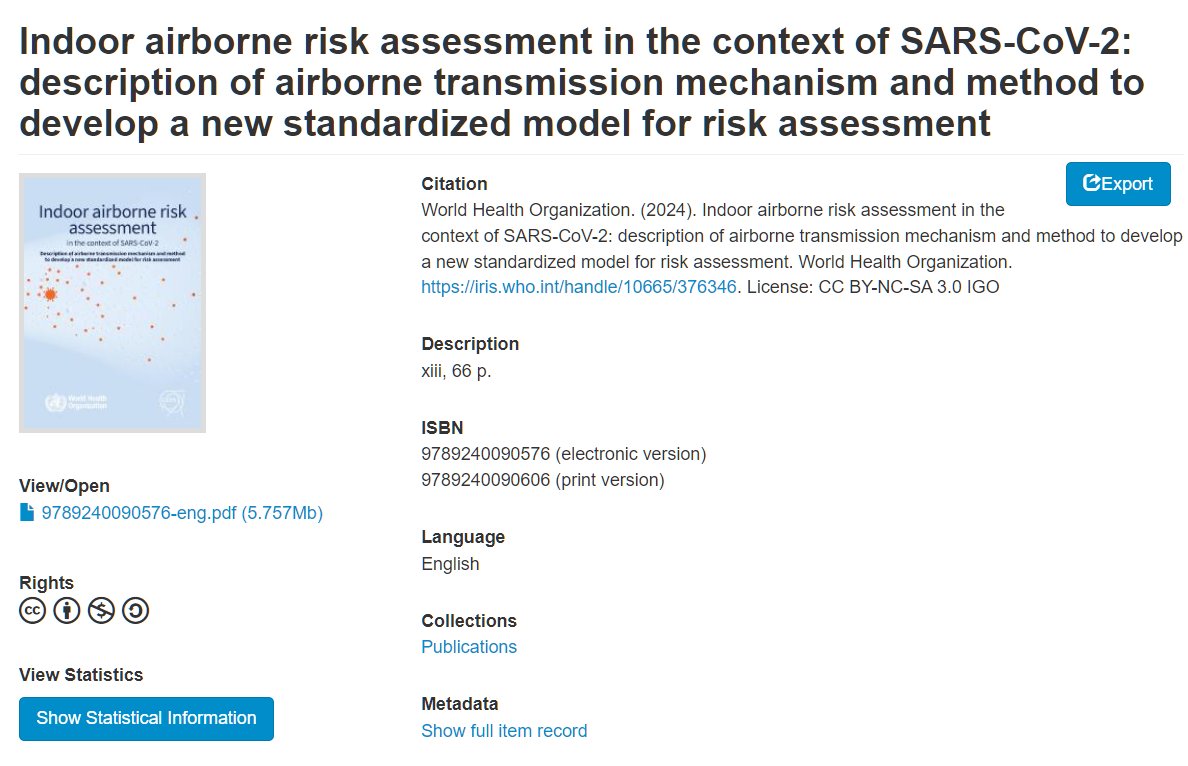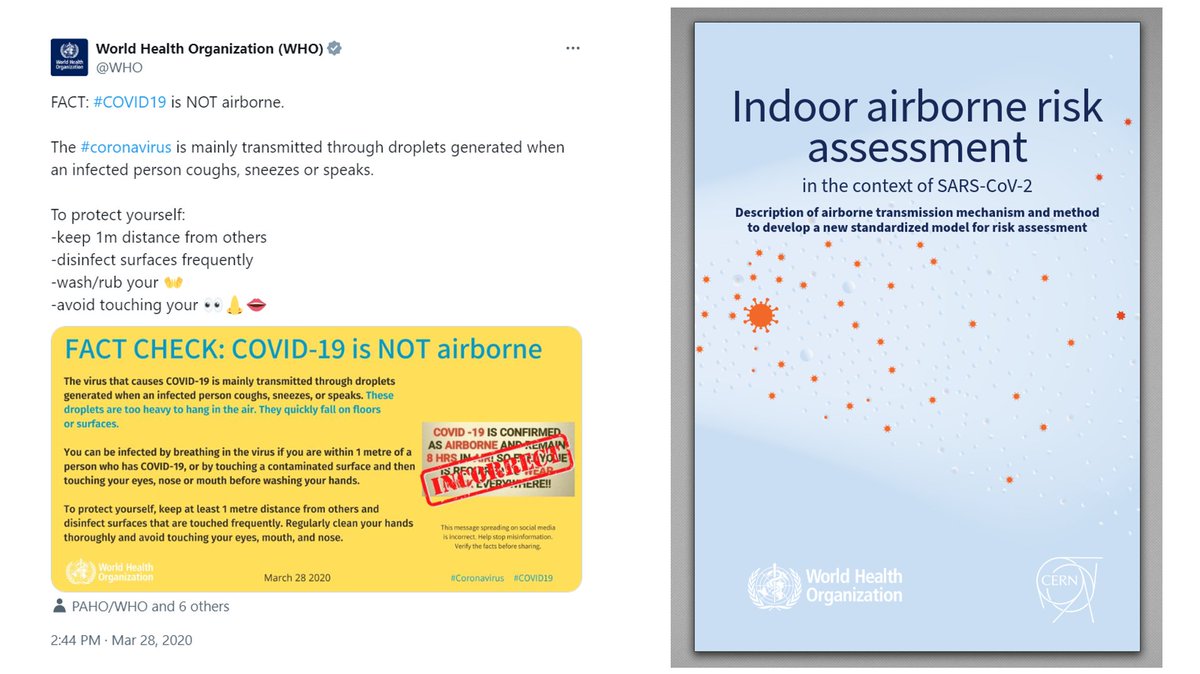FINAL OPTIMIZATION! Box fan single filter with 400 CFM measured at 120V. Estimated clean air delivery rate is 248 CFM CADR. Power is just 53 W, placing it well into Energy Star level for air cleaners. Room size: 384 sqft (8' ceilings). Cost: 🇨🇦$55 plus some tape. /1 

The filter is a single MERV-13 3M Filtrete 1900 which has the lowest pressure drop of the whole range. I also tested a Tex-Air 20x20x2 MERV-13 and there was no significant difference, it was 0.7% less flow, within measurement variation. /2 

Lifting the filter away from the back of the fan adds 8% more flow, and if cut a circular hole with 21 cm radius instead of a matching square, it adds another 3% more flow. /3 

Not only does the back box add 11% flow, it makes filter changes super easy.
And it provides a channel where some sound attenuation material could be placed, if desired. /4
And it provides a channel where some sound attenuation material could be placed, if desired. /4

Measurements were done with a flow capture hood with homemade version of an anti-swirl flow straightener. Backpressure compensation mode was used and 16 samples were taken of each configuration. Voltage was true RMS, and power was kill-a-watt meter. /5 



Materials:
A 20" box fan as shown below. Some names are Utilitech, Genesis, Hurricane, For Living.
The box it comes in.
A 3M Filtrete MPR 1900 (MERV-13) 20x20x1. Alternative: 20x20x2 MERV-13 Filter from Tex-Air Filters, or other brands. /8
A 20" box fan as shown below. Some names are Utilitech, Genesis, Hurricane, For Living.
The box it comes in.
A 3M Filtrete MPR 1900 (MERV-13) 20x20x1. Alternative: 20x20x2 MERV-13 Filter from Tex-Air Filters, or other brands. /8

Tape over the front to create a shroud. To maximize flow, tape to the ring at 13.5" (34.5 cm). This increases flow by 47%‼️
You can use a colorful duct tape. (I used painter's tape for temporary tests, you should use something better) /9
You can use a colorful duct tape. (I used painter's tape for temporary tests, you should use something better) /9

You saved the box, right? Seal it shut and rotate it for a good fit on the back (this one is slightly rectangular, works better on its side) /11 



For the back, center the filter and trace it with a marker. Freehand or measure out an offset frame and cut it out. ProTip: Use a new blade! Your cuts will be easier, cleaner, and safer. /12 



For the back shroud, trace around the case. Offset an inner frame edge and cut there, OR for an additional 3% more flow, identify the center and draw a circle with a compass, radius 21 cm and cut that out instead. /13 

Tape the spacer box on to the back of the fan, forming a complete seal with no cracks. You might want to add some foam in the channel formed by the box to reduce noise (I have not tried that yet) The spacer box increases flow by 8% /14 

Center the filter over the back and tape on all sides. You're done!
Stay tuned for more options and optimization using a 2-filter wedge, 4-sided box or 5- sided cube, plus measurements at lower speeds. /15
Stay tuned for more options and optimization using a 2-filter wedge, 4-sided box or 5- sided cube, plus measurements at lower speeds. /15

A Corsi-Rosenthal cube will definitely have more flow for the same level of noise.
But for cost-effectiveness this single-filter optimized design can have a huge impact on health, with widespread deployment. /16
But for cost-effectiveness this single-filter optimized design can have a huge impact on health, with widespread deployment. /16
https://twitter.com/native4data/status/1427045859150204933?s=20
🤔Does it strain the motor?
No! The shroud unloads the motor, lowers the power, and produces more flow. The extra resistance from the filter changes the point on the fan curve, resulting in less flow than without, but the same power consumption. /17
No! The shroud unloads the motor, lowers the power, and produces more flow. The extra resistance from the filter changes the point on the fan curve, resulting in less flow than without, but the same power consumption. /17
🤔What about fire risk?
It's fine. These are designed to be safe even if they fall flat on their front or back. And just to be sure, check out this safety report from scientists at Underwriter's Laboratories Inc! PDF: chemicalinsights.org/wp-content/upl… /18
It's fine. These are designed to be safe even if they fall flat on their front or back. And just to be sure, check out this safety report from scientists at Underwriter's Laboratories Inc! PDF: chemicalinsights.org/wp-content/upl… /18

🤔So is this better than a filter cube?
No! But it *is* far better than the same two materials taped together. The filter taped directly to the back of the fan is 245 CFM.
By optimizing the design, the flow is 400 CFM, a 63% improvement in performance! 🤯 /19
No! But it *is* far better than the same two materials taped together. The filter taped directly to the back of the fan is 245 CFM.
By optimizing the design, the flow is 400 CFM, a 63% improvement in performance! 🤯 /19
🤔Is this good for my classroom?🧑🏫
You need flow, as much as possible, and low noise. For that you should build one or two Corsi-Rosenthal boxes. Check out the mega-thread by @LazarusLong13, and I'll be doing further tests on them soon! /20
You need flow, as much as possible, and low noise. For that you should build one or two Corsi-Rosenthal boxes. Check out the mega-thread by @LazarusLong13, and I'll be doing further tests on them soon! /20
https://twitter.com/LazarusLong13/status/1425517352624410627?s=20
🤔How often should I change the filter?
It depends on the air it's filtering (forest fire smoke?) and run time. Suggest once every three months for this single-filter design.
A Corsi-Rosenthal box made from four or five filters might last a whole year. /21
It depends on the air it's filtering (forest fire smoke?) and run time. Suggest once every three months for this single-filter design.
A Corsi-Rosenthal box made from four or five filters might last a whole year. /21
🤔Will you patent it?
No! If anything, I hope fan manufacturers optimize their products. Lasko even makes a box fan with filter holder (model FF305) but didn't add a shroud, and ships with a low quality filter! Result: 42 CADR, versus 248 CADR. Drives me bonkers. /22
No! If anything, I hope fan manufacturers optimize their products. Lasko even makes a box fan with filter holder (model FF305) but didn't add a shroud, and ships with a low quality filter! Result: 42 CADR, versus 248 CADR. Drives me bonkers. /22

🤔What if I have a different fan?
The Lasko Comfort fan has a different optimal fan shroud size (15" opening).
Or, use tissue paper as nicely illustrated by @PragmaV. Good STEM activity for students! /23
The Lasko Comfort fan has a different optimal fan shroud size (15" opening).
Or, use tissue paper as nicely illustrated by @PragmaV. Good STEM activity for students! /23
https://twitter.com/PragmaV/status/1429716363610771461?s=20

Compare with the next size up: A two-filter wedge. Doubling the filter area (+200%) increases flow by 35% and slightly reduces noise. /25 

Here's a link to the next size up, the wedge, and how to construct it. /26
https://twitter.com/DavidElfstrom/status/1432291505365000197?s=20
• • •
Missing some Tweet in this thread? You can try to
force a refresh







![States high levels of CO2 and other contaminants ... can contribute to [list of five health effects, such as headaches, fatigue, difficultly concentrating], says CO2 should be below 1000 ppm, then says (incorrectly) that health effects from CO2 occur at levels above 5000 ppm. No, those effects can occur below 5000 ppm. It also states the CO2 concentrations do not indicate a risk of infectious disease transmission in a space. No, ASHRAE's position statement on CO2 states that elevated CO2 concentrations CAN reflect higher risk. Obviously, because it indicates poor ventilation, which IS an i...](https://pbs.twimg.com/media/GO6z_36WQAI7_mj.jpg)







